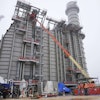The FutureGen Alliance on Tuesday unveiled its short list of candidate sites for a $1 billion first-of-its-kind, near-zero emissions coal-fueled power plant following an extensive technical review.
Of the 12 competing sites in seven states, the Alliance concluded that four sites are best suited to host the FutureGen facility. The sites chosen were Mattoon, Ill.; Tuscola, Ill.; Heart of Brazos near Jewett, Texas; and Odessa, Texas.
These candidate sites will move forward to the next step of the selection process, which includes a comprehensive National Environmental Policy Act (NEPA) evaluation by DOE and more detailed site characterization. In parallel, power plant engineering will proceed. In the latter half of 2007, following the completion of DOE's NEPA review, the Alliance will select a final site and move toward construction, and the plant is expected to be on-line in 2012.
"FutureGen will help meet the world's growing demand for clean electricity, fuel our global economy and sustain livelihoods," said Dr. Charles Goodman, Chairman of the FutureGen Alliance. "We have maintained an aggressive schedule since this international partnership formed in late 2005, and today’s announcement marks another important milestone in developing this critical technology solution."
With input from the U.S. Department of Energy (DOE), independent technical experts, Battelle, and other stakeholders, the site selection team developed nearly 100 peer-reviewed, publicly-vetted criteria against which each potential site was evaluated. The criteria were designed to reflect the scientific and technical goals of the project, as well as being consistent with the schedule and budget agreed to with the DOE, the Alliance's partner in the project.
Among the criteria evaluated: a minimum of 200 acres of land was required along with adequate cooling water; sites in close proximity to transmission lines and suitable geology for CO2 sequestration scored better than sites that were not; and the ability to access hydrogen and power markets.


















